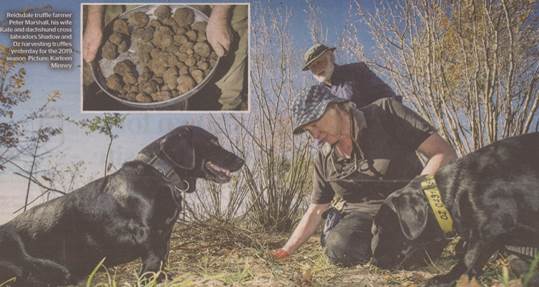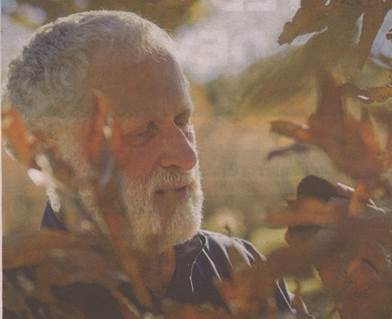By Finbar O'Mallon
It’s been 30 years in the making for Peter Marshall, but today he begins exporting his world-first French/Japanese hybrid truffles to Tokyo. Mr Marshall's achievement comes as the Canberra region's Truffle Festival kicks off with a “blessing of the dogs” on Sunday.

Reidsdale truffle farmer Peter Marshall, his wife Kate and dachshund cross labradors Shadow and Oz harvesting truffles yesterday for the 2019 season. Picture: Karleen Minney
IT'S something that's been 30 long years in the making for Peter Marshall, but he is exporting his first French-Japanese truffle to Tokyo on Wednesday.
The Reidsdale truffle farmer bought his degraded farmland three decades ago, hoping to use his background as a forester to restore the soil to how it was before Europeans arrived.
"It's a world first,” Marshall said. "We've been experimenting with about 220 different species of oak trees."
Не inoculated a Japanese kunugi oak with a French truffle. “We're the first people inthe world to handle a Japanese-French truffle.”
Even the chef for the Japanese embassy in Canberra and his wife visited to sample the truffles. Mr Marshall's achievement comes as the Canberra region's Truffle Festival begins this weekend. The event is estimated to bring about $8 million in tourism dollars to the region, according to a 2018 study from Central Queensland University.
Festival president Damian Robinson, a truffle farmer himself, said it was a massive drawcard for the region that attracted people from across the globe.
"The Canberra region's not, a big producer but the quality of truffles that come from this region are arguably the best in the world because of the incredible cold climate," Mr Robinson said.
“The frosts in winter tend to mature the truffle where the aroma is sensational.”
But what is a truffle? Mr Marshall said truffles were a type of fungus - a mycorrhizal fungi - that attach themselves to the roots on inoculated trees.
The truffles send out little roots mycelia - to bring more water and nutrients to the tree, which in turn generate sugars from photosynthesis to feed the truffles.
"It's a complete partnership,'' Mr. Marshall said. "The trees are healthier. The truffles are healthier because a happy tree gives them lots of sugar. "
But the truffles themselves want to be dug up by animals so they can spread their spores through animal droppings.
Truffle farming isn't for the faint-hearted. Mr. Marshall said he spent 10 years fixing the soil on his 600 acres, 10years planting and growing trees, then 10 years growing the truffles.
Mr. Marshall said the soil in Reidsdale used to be so soft that white farmers complained because their horses would sink through it.
After 150 years of heavy cattle and sheep, the soil became extremely compacted.
"The soil is so ceramic now, so flattened and baked, that it can't accept rain," Mr. Marshall said.
It took Mr. Marshall 10years of tilling his 600 acres with a special Yeomans plow-an Australian invention – to restore the soil to its pre-European softness. Even then, he was using his specialized Italian tractor which exerts less pressure on the ground underneath.
"That's me, up and down, up and down, for hundreds and hundreds of hours," he said. But thanks to all that hard work, Mr. Marshall's truffles thrive.

Reidsdale truffle farmer Peter Marshall with one of the truffles from his experimental Japanese oak.
Picture: Karleen Minney
Source: trufflefestival.com.au